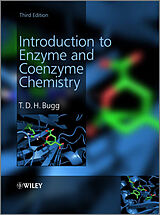Introduction to Enzyme and Coenzyme Chemistry
Format:
E-Book (EPUB)
EAN:
9781118348994
Untertitel:
Englisch
Genre:
Organische Chemie
Autor:
T. D. H. Bugg
Herausgeber:
Wiley
Auflage:
3. Aufl.
Anzahl Seiten:
280
Erscheinungsdatum:
29.05.2012
ISBN:
978-1-118-34899-4
Enzymes are giant macromolecules which catalyse biochemical reactions. They are remarkable in many ways. Their three-dimensional structures are highly complex, yet they are formed by spontaneous folding of a linear polypeptide chain. Their catalytic properties are far more impressive than synthetic catalysts which operate under more extreme conditions. Each enzyme catalyses a single chemical reaction on a particular chemical substrate with very high enantioselectivity and enantiospecificity at rates which approach catalytic perfection . Living cells are capable of carrying out a huge repertoire of enzyme-catalysed chemical reactions, some of which have little or no precedent in organic chemistry. The popular textbook Introduction to Enzyme and Coenzyme Chemistry has been thoroughly updated to include information on the most recent advances in our understanding of enzyme action, with additional recent examples from the literature used to illustrate key points. A major new feature is the inclusion of two-colour figures, and the addition of over 40 new figures of the active sites of enzymes discussed in the text, in order to illustrate the interplay between enzyme structure and function. This new edition provides a concise but comprehensive account from the perspective of organic chemistry, what enzymes are, how they work, and how they catalyse many of the major classes of enzymatic reactions, and will continue to prove invaluable to both undergraduate and postgraduate students of organic, bio-organic and medicinal chemistry, chemical biology, biochemistry and biotechnology.
Autorentext
Professor Timothy Bugg, Department of Chemistry, University of Warwick, UK
Professor Bugg is Professor of Biological Chemistry at the University of Warwick. Following his PhD studies with Dr C. Abell at the University of Cambridge he spent two years as a SERC/NATO postdoctoral research fellow in the laboratory of Professor CT Walsh at Harvard Medical School. In 1991 he began his academic career as a lecturer in organic chemistry at the University of Southampton, before moving to Warwick in 1999. His research interests are in the study of enzyme mechanisms, principally enzymes involved in the bacterial degradation of aromatic compounds, and enzymes involved in bacterial peptidoglycan biosynthesis. He has published approximately 100 journal publications since 1988, is the author of "An Introduction to Enzyme and Coenzyme Chemistry" (2 editions), and a contributor to "Comprehensive Natural Products Chemistry", and "Encyclopaedia of Chemical Biology" (for which he is on the Advisory Board).
Inhalt
Preface ix Representation of Protein Three-Dimensional Structures x 1 From Jack Beans to Designer Genes 1 1.1 Introduction 1 1.2 The discovery of enzymes 1 1.3 The discovery of coenzymes 2 1.4 The commercial importance of enzymes in biosynthesis and biotechnology 3 1.5 The importance of enzymes as targets for drug discovery 5 2 All Enzymes Are Proteins 7 2.1 Introduction 7 2.2 The structures of the L--amino acids 7 2.3 The primary structure of polypeptides 9 2.4 Alignment of amino acid sequences 11 2.5 Secondary structures found in proteins 12 2.6 The folded tertiary structure of proteins 15 2.7 Enzyme structure and function 17 2.8 Metallo-enzymes 19 2.9 Membrane-associated Enzymes 20 2.10 Glycoproteins 21 3 Enzymes are Wonderful Catalysts 25 3.1 Introduction 25 3.2 A thermodynamic model of catalysis 27 3.3 Proximity effects 28 3.4 The importance of transition state stabilisation 31 3.5 Acid/base catalysis in enzymatic reactions 34 3.6 Nucleophilic catalysis in enzymatic reactions 37 3.7 The use of strain energy in enzyme catalysis 41 3.8 Desolvation of substrate and active site nucleophiles 42 3.9 Catalytic perfection 44 3.10 The involvement of protein dynamics in enzyme catalysis 44 4 Methods for Studying Enzymatic Reactions 47 4.1 Introduction 47 4.2 Enzyme purification 47 4.3 Enzyme kinetics 49 4.4 The stereochemical course of an enzymatic reaction 55 4.5 The existence of intermediates in enzymatic reactions 61 4.6 Analysis of transition states in enzymatic reactions 64 4.7 Determination of active site catalytic groups 67 5 Hydrolytic and Group Transfer Enzymes 72 5.1 Introduction 72 5.2 The peptidases 73 5.3 Esterases and lipases 85 5.4 Acyl transfer reactions in biosynthesis (coenzyme A) 86 5.5 Enzymatic phosphoryl transfer reactions 88 5.6 Adenosine 5-triphosphate (ATP) 93 5.7 Enzymatic glycosyl transfer reactions 95 5.8 Methyl group transfer: use of S-adenosyl methionine and tetrahydrofolate coenzymes for one-carbon transfers 99 6 Enzymatic Redox Chemistry 108 6.1 Introduction 108 6.2 Nicotinamide adenine dinucleotide-dependent dehydrogenases 110 6.3 Flavin-dependent dehydrogenases and oxidases 115 6.4 Flavin-dependent mono-oxygenases 120 6.5 CASE STUDY: Glutathione and trypanothione reductases 122 6.6 Deazaflavins and pterins 126 6.7 Iron-sulphur clusters 127 6.8 Metal-dependent mono-oxygenases 128 6.9 -Ketoglutarate-dependent dioxygenases 131 6.10 Non-heme iron-dependent dioxygenases 133 7 Enzymatic CarbonCarbon Bond Formation 139 7.1 Introduction 139 Carboncarbon bond formation via carbanion equivalents 140 7.2 Aldolases 140 7.3 Claisen enzymes 144 7.4 Assembly of fatty acids and polyketides 146 7.5 Carboxylases: Use of biotin 150 7.6 Ribulose bisphosphate carboxylase/oxygenase (Rubisco) 151 7.7 Vitamin K-dependent carboxylase 153 7.8 Thiamine pyrophosphate-dependent enzymes 155 Carboncarbon bond formation via carbocation intermediates 158 7.9 Terpene cyclases 158 Carboncarbon formation through radical intermediates 162 7.10 Phenolic radical couplings 163 8 Enzymatic Addition/Elimination Reactions 170 8.1 Introduction 170 8.2 Hydratases and dehydratases 171 8.3 Ammonia lyases 175 8.4 Elimination of phosphate and pyrophosphate 177 8.5 CASE STUDY: 5-Enolpyruvyl shikimate 3-phosphate (EPSP) synthase 180 9 Enzymatic Transformations of Amino Acids 185 9.1 Introduc...

Leider konnten wir für diesen Artikel keine Preise ermitteln ...
billigbuch.ch sucht jetzt für Sie die besten Angebote ...
Die aktuellen Verkaufspreise von 3 Onlineshops werden in Realtime abgefragt.
Sie können das gewünschte Produkt anschliessend direkt beim Anbieter Ihrer Wahl bestellen.
Loading...
Die aktuellen Verkaufspreise von 3 Onlineshops werden in Realtime abgefragt.
Sie können das gewünschte Produkt anschliessend direkt beim Anbieter Ihrer Wahl bestellen.
| # | Onlineshop | Preis CHF | Versand CHF | Total CHF | ||
|---|---|---|---|---|---|---|
| 1 | Seller | 0.00 | 0.00 | 0.00 |
